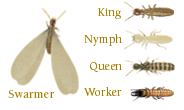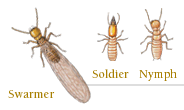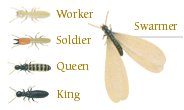[vc_row][vc_column][vc_column_text]
Drywood Termites
[/vc_column_text][vc_column_text]
 Drywood termites are social insects that live in colonies in sound, dry wood. Each colony consists of offspring from an original pair (male and female). There are three growth stages – eggs, immatures and adults. Drywood termites are larger than local, southwestern subterranean species.
Drywood termites are social insects that live in colonies in sound, dry wood. Each colony consists of offspring from an original pair (male and female). There are three growth stages – eggs, immatures and adults. Drywood termites are larger than local, southwestern subterranean species.
In comparison to other termites drywood colonies are rather small (a few thousand individuals), and the colony develops relatively slowly. They neither live in the ground nor maintain contact with the soil, and they do not build mud tubes.
Subterranean termites produce liquid feces, whereas drywood termites produce characteristic pellets. These pellets are eliminated from the galleries through “kick holes”. Pellets tend to accumulate on surfaces located below the kick holes and are usually the first evidence of a drywood termite infestation.
[/vc_column_text][/vc_column][/vc_row][vc_row full_width=”” parallax=”” parallax_image=””][vc_column width=”1/1″][vc_column_text]
Dampwood Termites
[/vc_column_text][vc_column_text]
 Dampwood termites typically infest damp and decaying timber. This species is commonly found in the Pacific Coast states, such as Montana, Idaho, Northern Nevada, Oregon, Northern California and Washington. Other but less damaging species are found in areas of Southwest USA and Southern Florida.
Dampwood termites typically infest damp and decaying timber. This species is commonly found in the Pacific Coast states, such as Montana, Idaho, Northern Nevada, Oregon, Northern California and Washington. Other but less damaging species are found in areas of Southwest USA and Southern Florida.
Identification of swarmers and soldiers: Dampwood termites are generally much larger than subterranean termites. The swarmers may be up to 1” in length, including their wings. The soldiers of dampwood termites have a large reddish-brown head and large multi-toothed mandibles (pincers). Dampwood termites contain various species, and are known to “swarm” to set up new nests during the year from January to October.
[/vc_column_text][/vc_column][/vc_row][vc_row full_width=”” parallax=”” parallax_image=””][vc_column width=”1/1″][vc_column_text]
Subterranean Termites
[/vc_column_text][vc_column_text]
 Subterranean termites Usually they live in the soil, but can be above ground if enough moisture is present. These termites build protective mud tubes ascending from the ground to the structure or protruding from walls. Subterranean termites are responsible for 95% of the termite damage caused to homes.
Subterranean termites Usually they live in the soil, but can be above ground if enough moisture is present. These termites build protective mud tubes ascending from the ground to the structure or protruding from walls. Subterranean termites are responsible for 95% of the termite damage caused to homes.
[/vc_column_text][/vc_column][/vc_row]
